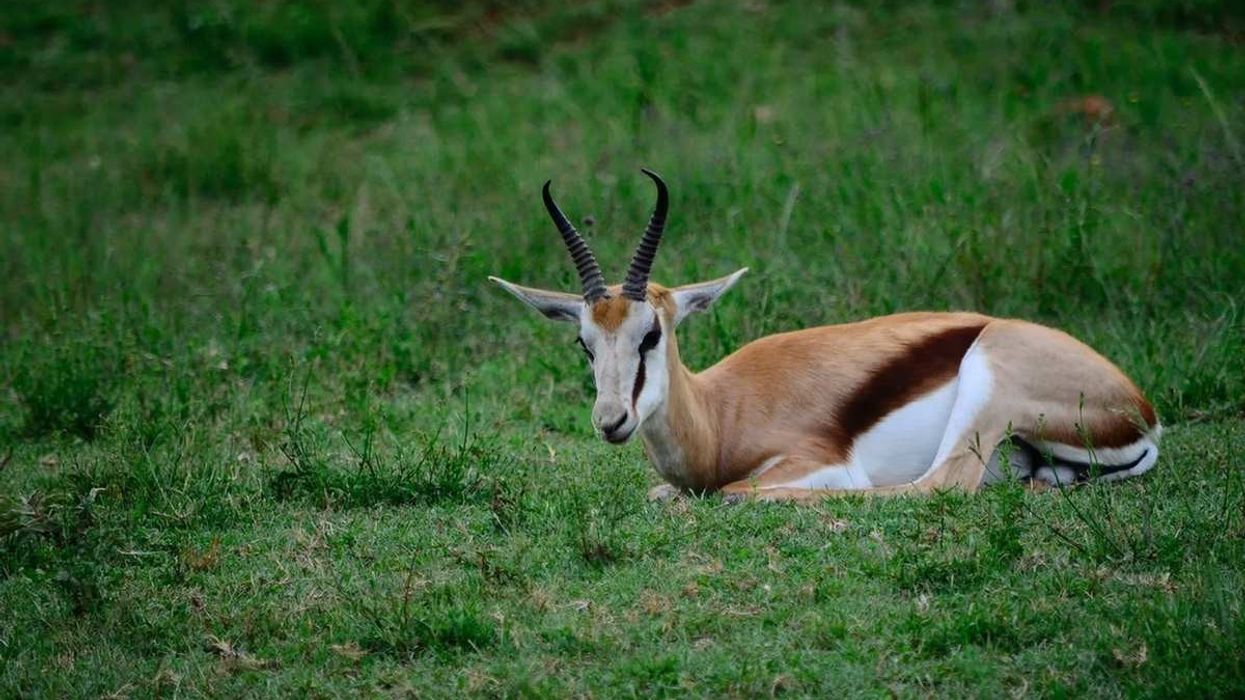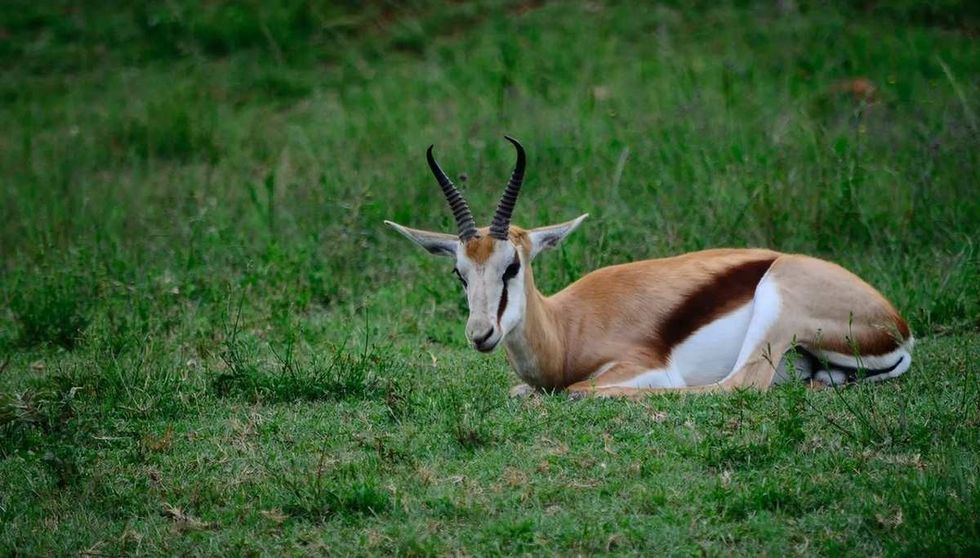A springbok is a mid-sized antelope species found in plenty in the southern parts of Africa. They are characterized by a tall and slender brown body with white hair and a white head with narrow, pointed ears.
They also have a white rump flap and reddish-brown stripes that run along their flank on either side. Springbok horns are long and curve at the top.
This species is known for two striking dark brown stripes that run symmetrically on their face. There may be mild variations in color, shades of brown, and horn structure among subspecies.
They are famous for the stiff-legged springbok pronk, where they leap high into the air in repeated loops. Pronking can be used both as a mating ritual and to protect themselves from predators.
The springbok (Antidorcas marsupialis) is considered as a small-sized gazelle among antelopes. It is also one of the rarest antelope species that has a thriving population of 2 million plus.
Despite being the national animal of South Africa, they are hunted as game in the continent for their prized meat and skin. This is considered legal as this is not an endangered species.
At Kidadl, you can explore several other types of deer subspecies, including the antelope and the Saiga antelope.
Springbok Interesting Facts
What type of animal is a springbok?
A springbok is a type of antelope, a four-legged animal.
What class of animal does a springbok belong to?
A springbok (Antidorcas marsupialis) belongs to the mammal class of animals.
How many springboks are there in the world?
Experts estimate that there are 2-2.5 million springboks spread across southern parts of Africa. It is also one of the rarest deer and antelope species with increasing numbers.
Where does a springbok live?
A springbok can live in grasslands and in the desert. While they feed on hay and occasionally grass, they also have the ability to survive a dry season without water. It is a grazer and lives in grasslands in South Africa.
What is a springbok's habitat?
An African springbok feeds on grass, hay, shrubs, and desert succulents. This diet makes it possible for them to survive in grasslands during the short African wet season and in desert-like conditions.
They have a wide home range spread across the African continent. Large populations of springboks thrive in southern Africa, especially in Angola and Botswana.
Who do springboks live with?
Springboks live in large groups of antelopes called a herd. They are also called a harem when one or more males live with a large number of females (1:3 ratio).
A mixed harem herd with both males and females can have as many as 120–150 springbok (Antidorcas marsupialis) living together. An all male herd can have 40-50 antelopes.
These large herd numbers give them the cushioning required to protect themselves from predators. In fact, if you find a solitary springbok, it is likely to have been separated from its herd by accident. Such an antelope will be extra cautious and on a constant lookout for predators.
There is also the harem nursing herd with females and their young ones. This is smaller in size, about 10 antelopes, and used during the gestation and nursing period of springbok females. Finally, males may get together to form a bachelor herd to actively seek out females.
How long does a springbok live?
A springbok can live up to 10 years in the wild in southern Africa.
How do they reproduce?
Unlike many mammals, a springbok antelope does not have a specific mating season or period. They can mate anytime during the year. The majority of the mating season happens in April, so their offspring have enough food to eat during the short wet season between October and November in southern Africa.
Females achieve sexual maturity first by the time they are six months old. Males can take up to two years to achieve sexual maturity. Males also have a 'rutting period' of one to three weeks when they are approached by females for mating. The male responds with a grunting noise and lowers his horns as a sign of interest.
Once the pair mate, females have a gestation period of 150–180 days. The average litter size is one calf, and in rare cases, twins.
Most calves are delivered in October and November, just before the rains start. Also, a few females may get together to form a harem nursing herd just before or after they deliver.
This is done to cover and protect calves for the first three to four weeks after they are born. During this time, calves may be more vulnerable to the elements and the presence of other animals.
Springbok calves remain with the mother for nursing until they are five to six months old.
What is their conservation status?
The conservation status of the springbok given by the IUCN is of Least Concern.
Springbok Fun Facts
What do springboks look like?
A springbok antelope is a surprisingly tall and slender creature for a springbok gazelle subspecies. It is still mid-sized, with a white head and a brown body, and a white rump flap.
It has white hair covering its entire body. This gazelle also has narrow and pointed ears and longhorns on either side. The horns curve backward at the top.
The Antidorcas marsupialis is identified by a striking visual feature of two distinct dark brown stripes on its face. The dark stripes run vertically across each eye.
How cute are they?
Springboks are very cute antelopes, pronking playfully as they run about their home range. This stiff-legged leap into the air is definitely a sight to behold.
How do they communicate?
Like most wild animals, they use both verbal and non-verbal cues to communicate. With verbal cues, they use a low-pitched sound to communicate happiness, say after a full meal. They use a high-pitched snort when they want to communicate fear or alarm like spotting a predator.
How big is a springbok?
A springbok is a medium-sized animal with a height of 28-33.9 in (71-86 cm) and a body length of 47.2-59 in (120-150 cm), It is approximately half the size of a sheep.
How fast can a springbok move?
Like most deer and antelope subspecies, a springbok is a super-fast animal. It can sprint at a racing speed of 55 mph (88.5 kph).
How much does a springbok weigh?
A springbok is a mid-sized antelope with a weight range between 58.5-92.6 lb (27-42 kg).
In contrast, the pygmy version royal antelope is the smallest antelope, with a weight range between 5.5–6.6 lb (2.5–3 kg). There is also the giant eland, which is the largest antelope, with a weight range between 661.4-2,645.5 lb (300-1,200 kg).
What are the male and female names of the species?
A male antelope is called a buck, and a female antelope is called a doe. This is common across all deer and antelope subspecies. Female springboks have thinner horns than their male counterparts. Males also tend to be heavier than females.
What would you call a baby springbok?
A baby springbok is called a calf.
What do they eat?
Springboks are herbivores and feed on grass, hay, and shrubs. They also gorge on succulents to fill themselves with water. In fact, they have the amazing ability to survive the entire South African dry season without water.
Springboks (Antidorcas marsupialis) are also considered prime prey by many wild predators in southern Africa, including lions, cheetahs, hyenas, and the South African wild cat.
Are they dangerous?
Springboks are herbivorous animals and not dangerous to humans. At most, they can catch you off-guard with their pronking when they suddenly jump high up into the air, almost up to 7 ft (2.1 m), to signify happiness or alarm.
Would they make a good pet?
They can make a good pet in theory, provided you can replicate their natural hot and dry habitat in your space. They also prefer to live in large groups of antelopes in a herd.
A springbok does not do well in isolation as it is likely to be wary of predators. Finally, springboks managed in a domestic habitat can be fed a wholesome diet of grass, hay, vegetables, and some fruit. Springboks are commonly considered as game rather than as a pet.
Did you know...
Present-day springboks feed on juicy succulents and are able to manage an entire dry season without water. This is critical to surviving the blazing hot climate typical to Africa.
In earlier times, this Antidorcas marsupialis species was known to migrate across large distances in search of food and water. They have recorded instances of springboks migrating in large numbers, from the Kalahari desert in Botswana in southern Africa to the Serengeti region in eastern Africa. This practice was known as trekbokking, like trekking.
Why is the springbok important to South Africa?
The springbok is considered important in South Africa for various reasons. First, it is the national animal. Secondly, they have an increasing population of over 2 million in Africa, so they are still considered game animals.
In fact, locals love to feast on springbok meat. They are also valued for their tough but soft skin. Also, the South African springbok skull head is commonly found as taxidermy in houses.
How does a springbok protect itself?
The Africa springbok (Antidorcas marsupialis) is a clever species and uses multiple techniques for protection. Here are three interesting springbok gazelle facts about how they protect themselves.
Firstly, a springbok animal lives with a large herd size of 50-150 antelopes. In fact, a springbok will go out of its way to avoid a solitary life.
Wild predators are less likely to approach an antelope when it is in a group. This antelope has the ability to unexpectedly jump high up in the air up to 7 ft (2.1 m), so they can catch the predator off guard and cover quite a distance. This is called pronking.
Finally, the speed of a springbok is fast. They can race at 55 mph (88.5 kph) which is much faster than most of their predators.
Here at Kidadl, we have carefully created lots of interesting family-friendly animal facts for everyone to discover! For more relatable content, check out these tarpan facts and gazelle facts for kids.
You can even occupy yourself at home by coloring in one of our free printable springbok coloring pages.









